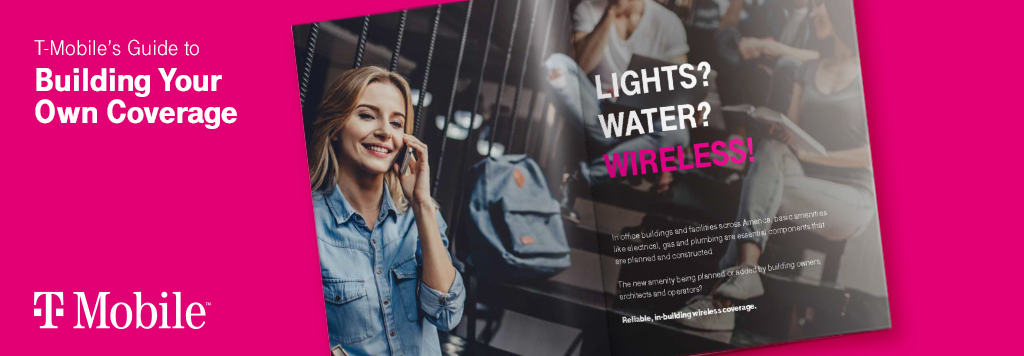Do You Have a Wireless Plan? A Strategic Question for Enterprises and Cities

This guest post is sponsored by T-Mobile. We are pleased to have T-Mobile as one of our Founding Sponsors for TIA’s Smart Buildings Program.
Guest Post by Luke Lucas
Senior Manager, National 5G SMART and In-Building Coverage
T-Mobile
Over the past few months, I’ve received messages from many building owners concerned about how poor connectivity may impact their buildings as the economy opens back up. Pre-pandemic, the hassle of moving or negotiating a new lease may have kept tenants put, even with slow speeds and poor coverage. But now, building owners are struggling to lure tenants back after months of staying home. Why should commercial tenants return to service worse than they’re getting at home? Add in the fact that 5G is now here. There was plenty of buzz about its impending deployment pre-pandemic which will return as people start getting back to their offices—but many enterprises and cities have not yet planned for implementation.
Based on my conversations, it seems like a lot of jurisdictions, enterprises, building owners, and operators need help to make the switch as seamless as possible. Many don’t know where to start.
The increased demand by tenants makes a lot of sense. After all, as carriers deploy 5G, new mobile standards are expected to unleash a plethora of technological tools that will enable buildings and cities to become “smart.” But first, cellular networks need to be upgraded so they can offer robust, high-performing services for offices, apartment and condo buildings, residential neighborhoods, and even transportation systems. If the pandemic has taught us anything, it is that reliable connectivity is more important than ever.
A smart-connected world is exciting to contemplate, but like all good things, it will take effort to get there. Cellular carriers must not only upgrade their macro networks, they will also need to “densify” the network with equipment that will provide coverage and capacity deep inside buildings and in public settings where thousands of people pass through daily. Deploying these upgrades will require participation and planning by businesses and cities whose properties will become part of this vibrant infrastructure.
Planning to Bring Connectivity to Buildings and Cities
Businesses and cities have a strategic interest in 5G deployments because people who use their facilities expect high-performing services. User expectations and overall demand will only increase. Office buildings must be better connected so employees can be more productive and help their employers succeed. Connected buildings and public facilities will lead to better-connected cities, which will help local economies. Better connectivity also ensures everyone can dial 911 in case of emergencies – essential for public safety. Conversely, buildings and cities that have coverage gaps or dead spots will be disadvantaged and unable to fully realize the capabilities 5G will bring.
But to deliver on the promises of 5G, owners and operators do need to make a plan. They need to understand how connected (or not connected) their venues are today, what is needed to support 5G, and how to partner with infrastructure firms to bring 5G to their properties. Typically, an enterprise, campus or building will need a system that can deliver cellular connectivity throughout a property.
Multiple approaches and business models exist but here at T-Mobile, we recommend owners and operators find an independent firm or systems administrator to design and deploy an indoor network for them, that they will own and control. Once the infrastructure is deployed, cellular carriers will sign leases to connect their services to the system.
Checklists for Convenient Planning
If you’re a building owner, manager, tenant, real-estate developer or government administrator and you don’t have a wireless plan for 5G, you can use one of T-Mobile’s simple checklists to get started.
Use the Smart Building Checklist to help you assess your needs and establish next steps. You’ll want to assess coverage from major carriers in your facility, install ample fiber, make sure you have electric power and connections in place for network equipment, and run conduit throughout your premises so you can extend cables to any location.
For cities that want to support smart applications and services, use the Smart Cities Checklist to guide the planning process. In general, you will need to evaluate outdoor wireless coverage for all carriers, identify fiber requirements, make sure your electricity grid is adequate, identify city-owned assets and property that can be used for infrastructure, and review all commercial properties for wireless signal penetration. We recommend surveying city departments and constituents to learn where there may be a lack of strong cellular coverage. You will also need to map your city with a geographic information system (GIS).
Looking for More Help?
With T-Mobile’s Build Your Own Coverage program, our network teams take an Un-carrier approach to indoor wireless networks, and can help remove pain points and streamline the technology deployment process – ensuring owners and operators get the indoor wireless network that meets their needs – today and in the future.
Please visit www.T-MobileBYOC.com for additional information or connect with me on LinkedIn.

